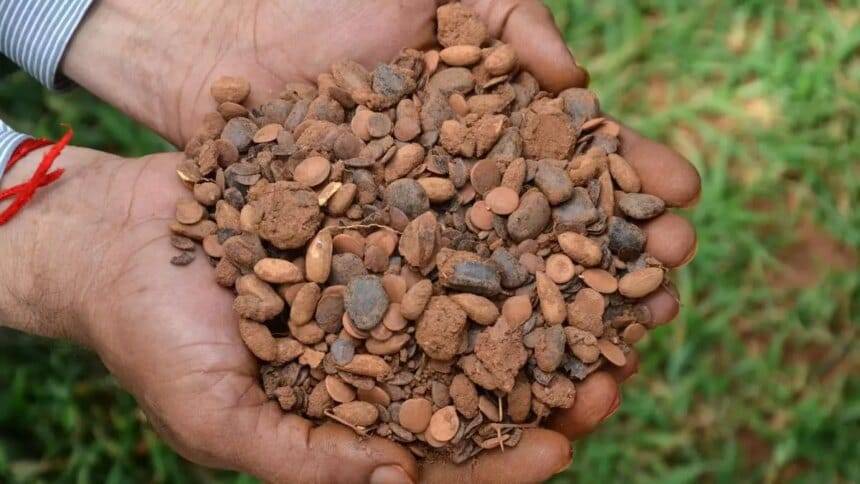Main Points In Hindi (मुख्य बातें – हिंदी में)
-
बीज किस्मों की घोषणा: प्रधानमंत्री नरेंद्र मोदी ने अगस्त में 109 नए बीज किस्मों का विमोचन किया, जिनमें से 20 रबी मौसम के लिए उपयुक्त हैं, लेकिन अभी तक उन पर कोई आधिकारिक अधिसूचना जारी नहीं की गई है।
-
अधिसूचना में देरी: उच्च स्तरीय पैनल ने सितंबर में इन बीज किस्मों को मंजूरी दी, लेकिन इसके बाद भी कृषि मंत्रालय ने आवश्यक अधिसूचना जारी नहीं की, जिससे व्यावसायिक खेती में देरी होने की संभावना जताई जा रही है।
-
बीज प्रजनकों की चिंताएँ: बीज प्रजनकों का मानना है कि नई किस्मों के लिए अधिसूचना को बुआई के मौसम से कम से कम एक महीने पहले जारी किया जाना चाहिए, ताकि वे ब्रीडर बीजों के उत्पादन की योजना बना सकें।
-
प्रक्रियाएँ सुधारने के प्रयास: केंद्र सरकार ने बीज क्षेत्र में सुधार लाने के लिए सीडनेट पोर्टल को SATHI पोर्टल के साथ विलय करने का निर्णय लिया, जिससे संबंधित जानकारी एक ही स्थान पर उपलब्ध हो सकेगी।
- किसानों को जागरूक करना: प्रधानमंत्री ने कृषि विज्ञान केंद्रों को निर्देशित किया कि वे किसानों को नई विकसित बीज किस्मों के लाभों के बारे में माहिर करें, ताकि अधिकतम उत्पादकता प्राप्त की जा सके।
Main Points In English(मुख्य बातें – अंग्रेज़ी में)
Here are the main points from the article:
-
Seed Variety Release: Prime Minister Narendra Modi announced the release of 109 high-yielding and climate-resilient seed varieties in August as part of the government’s 100-day program. Among these, 20 varieties are suitable for the rabi season.
-
Notification Delay: Despite the approval of these seed varieties by a high-level panel in September, the government has not yet issued the necessary notifications, which may delay commercial farming activities.
-
Impact on Farmers: Farmers could face a wait of 2-3 years to commercially use these newly developed seeds after they have been bred by seed developers.
-
Collaboration and Awareness: The government aims to improve the seed sector by merging existing platforms for seed certification and providing farmers with information about the benefits of new varieties through agricultural science centers.
- Upcoming Meetings: A follow-up meeting concerning the seed varieties is scheduled for November, with ongoing discussions about the frequency of meetings to expedite notifications for new seed varieties.


Complete News In Hindi(पूरी खबर – हिंदी में)
प्रधान मंत्री नरेंद्र मोदी ने सरकार के 100-दिवसीय कार्यक्रम के हिस्से के रूप में अगस्त में 109 बीज किस्मों को जारी किया। इनमें से 20 किस्में रबी मौसम के लिए उपयुक्त हैं, लेकिन बुआई का मौसम शुरू होने के बावजूद उन्हें अभी तक अधिसूचित नहीं किया गया है। हालांकि बीज अनुमोदन पर उच्च स्तरीय पैनल ने सितंबर में इन किस्मों को मंजूरी दे दी, लेकिन सरकार ने अभी तक अधिसूचना जारी नहीं की है। इससे संभावित रूप से व्यावसायिक खेती में देरी होगी। बीज प्रजनकों द्वारा बीज विकसित करने के बाद उनका व्यावसायिक उपयोग करने के लिए किसानों को अगले 2-3 वर्षों तक इंतजार करना पड़ सकता है।
आधिकारिक सूत्रों के अनुसार, गन्ने की चार प्रजातियाँ थीं, मक्का और मसूर की तीन-तीन, गेहूँ और चने की दो-दो प्रजातियाँ थीं।चना), कुसुम और अनाज चौलाई और रबी मौसम के लिए उपयुक्त जौ और बरसीम की एक-एक किस्म।
प्रक्रिया के तहत
सूत्रों ने कहा कि कृषि फसलों के लिए फसल मानकों, अधिसूचना और किस्मों की रिहाई पर केंद्रीय उप-समिति ने 2 अगस्त को अपनी बैठक में अधिसूचना के लिए इन किस्मों को मंजूरी दे दी, सूत्रों ने कहा कि बैठक के मिनट सितंबर के पहले सप्ताह में ही प्रसारित किए गए थे। . सूत्रों ने कहा कि कृषि मंत्रालय आवश्यक अधिसूचना जारी करेगा, जो प्रक्रियाधीन है।
रबी सीजन के लिए प्रधानमंत्री ने HI 1665 और HI 8840 (गेहूं), DWRB-219 (जौ), PG 265 और NbeG 1267 (चना), PL 320, कोटा मसूर 6, PSL 17 (मसूर), ISF-123 का लोकार्पण किया. -सेल-15, आईएसएफ 300 (कुसुम), जेबी 08-17 (बरसीम), सीओ 17018, सीओएलके 16202, सीओएलके 16470, सीओपीबी 17215 (गन्ना), एपीसीएच-2, एपीसीएच-3, आईएमएच 230 (मक्का), आरएमए 120 और 11 अगस्त को 34 कृषि और 27 बागवानी फसलों की 109 उच्च उपज देने वाली, जलवायु-लचीली और बायोफोर्टिफाइड बीज किस्मों के हिस्से के रूप में जीए 8 एसकेएनए 1407 (अनाज ऐमारैंथ)। इन्हें कृषि उत्पादकता और किसानों की आय बढ़ाने के लिए आईसीएआर के विभिन्न अनुसंधान केंद्रों द्वारा विकसित किया गया था।
सूत्रों ने कहा कि अगली बैठक नवंबर के लिए निर्धारित की गई है।
प्रजनन एजेंसियों का दृश्य
हालाँकि, बीज गुणन एजेंसियों का मानना है कि बुआई का मौसम शुरू होने से कम से कम एक महीने पहले अधिसूचना सुनिश्चित की जानी चाहिए ताकि नई विकसित किस्मों को लेने वालों को ब्रीडर बीजों के उत्पादन की योजना बनाने के लिए पर्याप्त समय मिल सके। एक बीज कंपनी के एक शीर्ष अधिकारी ने कहा, “यदि आवश्यक हो तो उप-समिति की बैठकें अधिक बार होनी चाहिए, क्योंकि आवेदन जमा करने और एक ही बार में खरीफ और रबी दोनों मौसमों की 300 से अधिक किस्मों को मंजूरी देने का कोई मतलब नहीं है।”
केंद्र ने बीज क्षेत्र में सुधार लाने के लिए मौजूदा सीडनेट पोर्टल को हाल ही में लॉन्च किए गए SATHI (बीज प्रमाणीकरण, ट्रैसेबिलिटी और समग्र सूची) पोर्टल के साथ विलय करने का भी निर्णय लिया है क्योंकि मांग-आपूर्ति के साथ-साथ नियामक मुद्दों से संबंधित सभी प्रकार की जानकारी उपलब्ध होगी। एक ही स्थान पर हो.
प्रधान मंत्री ने पहले सुझाव दिया था कि कृषि विज्ञान केंद्रों (केवीके) को उनके लाभों के बारे में जागरूकता पैदा करने के लिए विकसित की जा रही नई किस्मों के लाभों के बारे में हर महीने किसानों को सक्रिय रूप से सूचित करना चाहिए। आईसीएआर के वैज्ञानिकों ने कहा कि वे क्षेत्र प्रदर्शन के साथ विस्तार नेटवर्क के माध्यम से अप्रयुक्त किस्मों को मुख्यधारा में लाने के लिए काम कर रहे हैं।
Complete News In English(पूरी खबर – अंग्रेज़ी में)
Prime Minister Narendra Modi launched 109 new seed varieties in August as part of the government’s 100-day program. Of these, 20 varieties are suitable for the rabi (winter) season, but they have not yet been officially approved for use, even though a high-level panel gave the green light for them in September. This delay in notification could potentially hinder commercial farming, requiring farmers to wait 2-3 years after the seeds are developed by breeders before they can use them.
According to official sources, the varieties include four types of sugarcane, three each of corn and lentils, two each of wheat and chickpeas, as well as one variety each of barley, berseem clover, and quinoa suitable for the rabi season.
The sub-committee on crop standards approved these varieties for notification during a meeting on August 2, but the meeting minutes were only shared in the first week of September. The Agriculture Ministry is expected to issue the necessary notification, which is still in progress.


The Prime Minister introduced several new varieties for the rabi season, including types of wheat, barley, chickpeas, lentils, and corn. These seeds are designed to be high-yielding, climate-resilient, and bio-fortified, developed by various research centers under the Indian Council of Agricultural Research (ICAR) to enhance agricultural productivity and increase farmers’ income.
Sources indicated that the next meeting on this topic is scheduled for November.
Seed breeding agencies argue that notifications should be made at least a month before the sowing season starts to give breeders enough time to produce breeder seeds. A senior official from a seed company stated that sub-committee meetings should occur more frequently to address the approval of over 300 seed varieties for both the kharif and rabi seasons effectively.
To improve the seed sector, the government is merging the existing SeedNet portal with the newly launched SATHI portal for seed certification, traceability, and a comprehensive list of seed varieties, providing all necessary information in one place.
The Prime Minister previously suggested that KVKs (Krishi Vigyan Kendras) should actively inform farmers monthly about the benefits of the new varieties being developed. ICAR scientists are working on bringing underutilized varieties to the mainstream through field demonstrations and extension networks.
Source link




